Top Story: Social Services
DCFS under microscope again
June 26, 2013

Supervisor Yaroslavsky, arguing against a new commission, says now is the time for action, not more recommendations. Here, he displays five years worth of board motions to examine DCFS operations.
Faced with another controversy over the failure of social workers to remove a child from a dangerous home, a divided Los Angeles County Board of Supervisors this week approved the creation of a blue-ribbon panel to investigate the Department of Children and Family Services and recommend reforms—the latest in a series of examinations stretching back decades.
The board’s action, on a 3-2 vote, follows the death last month of 8-year-old Gabriel F. of Palmdale, who was allegedly tortured by his mother and her boyfriend, both of whom are being held on murder charges. Social workers had earlier received multiple reports of abuse and neglect involving Gabriel, only the most recent child fatality to generate headlines and public outrage over the years.
The push for an independent panel came from Supervisors Mark Ridley-Thomas and Michael D. Antonovich and is modeled after the Citizens’ Commission on Jail Violence, which last year recommended dozens of reforms to curb brutality by sheriff’s deputies assigned to the county lockup. Its members, who included former judges, prosecutors and a prominent pastor, were appointed by the Board of Supervisors, who’ll also pick the new panel.
During Tuesday’s meeting, all five supervisors expressed deep frustration over the tragedies that have continued to plague DCFS and have prompted numerous management shakeups and hundreds of recommended reforms from oversight bodies. But the supervisors broke ranks on how best to achieve the foremost goal of keeping youngsters safe, with Ridley-Thomas, Antonovich and Gloria Molina voting for the commission and Zev Yaroslavsky and Don Knabe voting against it.
The proponents argued it was time for a fresh look by a group of independent, highly-respected individuals, who’d be given the authority to examine not only DCFS but other local agencies with which it interacts. The opponents, meanwhile, argued that DCFS’s director, appointed a little more than a year ago, already has made strides—including the adoption of a new strategic plan and training curriculum—and should not be distracted from the job at hand at a critical moment for the department.
Here are condensed excerpts of what each had to say, along with the edited remarks of DCFS Director Philip Browning:
Mark Ridley-Thomas
“Since 2008, there have been over 100 motions on our respective parts. Our collective effort is well documented. But when the time comes to turn our collective will into effective actions, unfortunately we have fallen short. There are times when government is unable to transcend a stagnant set of circumstances. Status quo needs to be altered. And so by establishing a blue-ribbon commission, we can finally get down to why these recommendations have not been implemented and understand what needs to be done. The commission is not intended to re-invent the wheel. Rather, the intent is to get the wheels turning and DCFS and related agencies moving forward. The blue ribbon commission will serve a very distinct role. Some have argued that we already have a children’s commission, so there’s no need for a blue ribbon commission. I would just simply say commissions can and do make governance more dynamic. They are less likely to be politicized and more inclined to be singularly focused, clinical in their pursuit and, therefore, have the opportunity to add significant value… particularly for this population that is so clearly vulnerable.”
Zev Yaroslavsky
“There isn’t a member of this board that doesn’t care deeply about the children who are our responsibility. Nothing makes me more angry than to see a child suffer anywhere, whether it’s in L.A. County, or on my block or in any part of the world. But the question is: how do you get it done? I can almost verbatim tell you what the commission report will say: ‘You’ve got to hire a lot more social workers.’ ‘You’ve got to have more accountability and more transparency.’ All of the kinds of things we have asked our current director to do. And we need at some point to let the current director breathe and do his work under careful scrutiny and accountability by the board. I’m, as many of you know, an adherent of John Wooden, the former UCLA basketball coach, who had a great line, among many great lines, which is: “Don’t mistake activity for achievement.” I think our challenge now is to execute what we know needs to be done. If we had never done this before, if there had never been a study of DCFS before, if there had not been a barrage of state audits before, had there not been a CSIU [investigative unit], then I would say a blue-ribbon commission is the way to go. But it’s ‘activity.’ And whether there’s achievement remains to be seen.”
Gloria Molina
“Very frankly, we’re not finding a solution [to child deaths]. And I wish it were just a problem in L.A. County. When you look at it across-the-board, whether you’re in Chicago, New York, San Francisco, you have the same issues: how to handle it and what we’re doing. There must be something that we’re missing. And so having a set of fresh eyes look at that is a good thing because I know I would be willing to accept a new set of recommendations. I really think that everything in that department has to change and has to change dramatically—everything from training our social workers to hiring our social workers to bringing accountability and, more importantly, to training our managers [who] in most instances can’t manage anything. But I applaud that we are moving forward in this direction. Until the blue ribbon commission concludes its review and analysis and this board acts upon its recommendations, it is the responsibility of this board…to immediately ensure this department continues to provide safety for children under their supervision.”
Don Knabe
“The minute something goes wrong, what do we do? We have another reaction to the media. We have another commission. We have another set of 99½ recommendations. Another rehash of everything we know that’s on the table. I think we’re all tired of hearing recommendations. We already know what needs to be fixed. We all want action and the greatest fear is that our department, DCFS, will come to a screeching halt because we are drowning in recommendations and losing that direction. And this blue ribbon commission would bring it to a total halt…What are they going to tell us that we don’t already know? After all the other recommendations and all of the advice that we have received over the years, what is sorely lacking is the refusal to set aside the many distractions and just get the job done. We must send a message as a board of zero tolerance of any action that exposes our children to harm. Another commission, I don’t think personally, will address those problems or set us on a path in the future. Another commission will just be a distraction to the very, very important work at hand.”
Michael D. Antonovich
“Just for the record, this motion [for a commission] does not inhibit the Department of Children and Family Services from moving forward with the implementation of their strategic plan and some of the most critical components, including the revamping of the training curriculum, policy manual rewrite and staffing reorganization. But what it does do is focus on a very serious issue and brings to a head the problem with recommendations.”
Philip Browning, director DCFS
“In my 40 years of public, private, military service, I’ve never turned down any help and I don’t intend to today. I do believe that there is some value in having a set of fresh eyes look at things. I know I learn something new every day. I do believe also that it’s critical that we have individuals [on the panel] who are knowledgeable, professional, independent, have no conflict of interest in order to really move this department forward. We’ve had some tragedies lately that are just unspeakable. We’re going through a process of investigations and hopefully we’ll get to a conclusion pretty soon. The most important thing I think I’d like to leave you with is that safety, in my opinion, is our primary goal. It’s job one for us. Frankly, most of the situations that don’t end up well don’t occur in foster homes or group homes. They occur when we’re trying to keep children in their families. And that is a very, very tough job. And it is one that they often don’t get thanked for.”
Posted 6/27/13
Dad pride
June 13, 2013
As we prepare to celebrate our nation’s dads this weekend, how’s this for a heroic (not to mention exhausting) feat of fatherhood? For three consecutive months in mid-2005, Los Angeles County social workers delivered three tiny foster children to a couple who’d once tucked away any hope of being parents.
The oldest of the children was 18 months. The middle one was 4 months. And the youngest had been in the world for just 3 days.
“We made it through that glorious summer, a scorcher without air conditioning,” says John Ireland, as he recalls the diapers and feedings and joys of it all. “It was such a tremendous, intensive parenting experience”—one made even more complicated by the demographics of the household. For there were two men of the house, “Dad” and “Daddy.” John is married to Duncan Ireland, his partner of 20 years.
Like many gay men, John, 42, says he’d come to believe the subtle and overt messages in society that parenthood was out of reach for people like him. His own parents, he says, “let go” of their hopes of having grandchildren through him after he “came out.”
But all that changed, John says, after he and Duncan talked to social workers from L.A. County’s Department of Children and Family Services and the Southern California Foster Family & Adoption Agency during an informational fair at Plummer Park in West Hollywood.
“We were not only welcomed, we were actively recruited,” John says, noting that he and Duncan, 40, promptly underwent nine training sessions for certification as foster parents. That training included an emphasis on family transparency. “What they need is honesty. You don’t avoid any topics with a foster child,” says John, who was wed to Duncan in 2008, before California voters banned same-sex marriage through Proposition 8, which is under review by the U.S. Supreme Court.
In all, the couple provided foster care to four children, eventually adopting a sister and brother, now 8 and 5, respectively. “We would have adopted them all, if we could have,” says John, a consultant and fundraiser for non-profit groups who served as the stay-at-home dad while Duncan continued his law practice. Today, John helps lead an organization called Raise A Child, which works with the county and others to spread the word about opportunities for gays and lesbians to become foster and adoptive parents.
County child welfare officials know that some people may not approve of the government actively seeking gay and lesbian parents. But those officials say the county needs every willing and qualified adult possible to provide a safe and caring environment for the more than 16,000 foster youth who must be removed from dangerous homes.
“We need to recruit everyone who can help us”—including lesbian, gay, bisexual and transgender couples and individuals—says DCFS supervising children’s social worker Bryan Miller. “The LGBT community has been an underutilized resource for many years. We’re just catching up.” Miller says a UCLA study last year concluded that foster children do equally well when placed with gay, lesbian or heterosexual parents.
As for the critics, Miller offers this challenge: “If you’re going to complain, I want to see you at our next foster/adoption orientation.”
In recent years, the county’s foster care system has come under intense scrutiny and criticism for sometimes failing to protect the welfare of children living in group or individual homes. Just this week, the Board of Supervisors voted to end a decades-long relationship with Teens Happy Homes amid allegations of financial improprieties and child abuse detailed in the Los Angeles Times. But what rarely rises to the surface are the many profound and touching stories of success. As John explains: “These victories are small and only celebrated by those of us observing them happen.”
The experiences of John and Duncan, both as foster and adoptive parents, deserve a wider celebration.
As foster parents, John says, you’re trained to brace for the reality that the children you’ve grown to love may be reunified with relatives. That’s what happened with two of those first three youngsters to enter the couple’s life in rapid succession—Marisol and her infant brother, Isaías. Five months after coming to the Ireland home, the children were adopted by an aunt living near Staples Center in downtown Los Angeles. “We thought we’d never see them again,” John recalls.
When he and Duncan arrived at the aunt’s apartment, siblings in tow, she asked whether they had a keepsake photograph of the children and their foster parents. In fact, John had stashed a framed picture in their suitcase. He dug it out and handed it to her. To the men’s astonishment, she removed an image of the Virgin Mary from a wall and replaced it with the new photo.
“You are part of their lives and we want you to be part of our family,” she told them, a vow to which she’s stayed true during the past eight years by inviting the couple to birthday parties and other special occasions. “That was the best thing for those children,” John says in hindsight. “It worked exactly as the foster system was meant to be.”
As for baby No. 3, Emma, the couple adopted her in late 2005, six months after she first came to their home. And she remained an only child for nearly seven years, until John got a mid-morning call while driving along Laurel Canyon Boulevard. “Pull over and turn off the car,” an excited social worker advised. Emma’s 4-year-old brother, she reported, had entered the foster care system. Little Giovanni, who joined the family as a foster child in July, 2012, was adopted last month.
“He was so excited about being adopted,” John says, “that for two weeks when he woke up in the morning he’d ask: “Am I still a foster kid?” I’d tell him, ‘Nope, you’re no longer a foster kid.”
John is under no illusions that his family choices will be widely embraced, especially by those outside “the bubble” of Los Angeles. Not only are there two dads, but they’re white with African American children. “We don’t walk into a restaurant undercover,” he joked.
Asked what unique challenges gay couples confront, John says: “The biggest challenge is helping our kids navigate a society that is very focused on us. The spotlight is trained on our families. It’s still very controversial in our culture for gays and lesbians to parent.”
“The hardest part,” he continues,”is when we go into public. The kids are old enough to see the looks or be posed the questions in school. ‘Why do you have two dads?’ We have to prepare them to answer those questions.”
Two weeks ago, he says, he and his husband took the youngsters to a gay pride festival in the Antelope Valley. Along the road to the fairgrounds were protest signs warning, “Homo sin. Turn back.”
“How do you prepare a 5-year-old or an 8-year-old for that? We tell them that people have the right to express themselves. Some people do not agree with our family. Some people do not like families with only one parent.…The truth is that every kid has something they can be picked on about. Kids need to be taught resilience.”
This Sunday, none of those questions or pressures will be in the air when John, Duncan and their two high-energy, toothy-grinned kids who love handball and running attend “The World’s Largest Gay Father’s Day Celebration,” which includes brunch and a children’s concert.
The event is sponsored by, among others, John’s Raise A Child group, the City of West Hollywood and the Pop Luck Club, an organization of gay dads, prospective dads and their families. John is the current president, with duties that include storing the club’s banners in his garage and making sure there’s plenty of Capri Sun juice boxes for monthly potlucks.
Says John: “I think I’m the luckiest guy in the world…besides my husband.”
Posted 6/13/13
It’s a safe new world for Valley youth
May 29, 2013
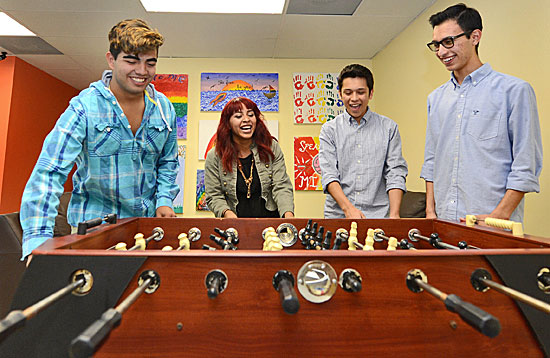
Dropping in for some foosball are, from left, Edward Murillo, Karina Perez, Anthony Barros and Mario Vasquez.
Edward Murillo knows what it’s like to need a refuge.
As a gay teenager growing up in South Lake Tahoe, he says, he was kicked out of the house a dozen times. “The first time, I slept out in the woods,” he recalls.
Now 20, and living with an aunt and uncle in Sun Valley, he’s a student at Pierce College and a leader of its Gay-Straight Alliance club.
And this week, he was definitely out of the woods, sitting in a bright and freshly painted new drop-in center for at-risk, foster, homeless and LGBT young people aged 14 to 21. The center, which formally opens Friday, is the first of its kind in the San Fernando Valley.
“I feel like if there was a center like this in Lake Tahoe, it would have been amazing. It would have made me feel a lot better,” Murillo says.
Charles Robbins, vice president of communications and development for The Village Family Services, which has created the center on the site of a former orthopedic surgeon’s office in North Hollywood, says it will serve a growing population with urgent and specific needs.
“We are going to be a heavily-used site,” he predicts, noting a “migration” of homeless youth to the Valley as crackdowns intensify in Hollywood. “Lots of these kids are coming into North Hollywood.”
He says that many of the young people end up “couch-surfing with friends,” while others frequent local libraries, public transit stations and parks.
Some offerings at the new center are geared to addressing the needs of homeless kids—showers, a washer-dryer, a few basic clothing supplies. Others, like an outdoor patio, foosball table, free Wi-Fi and “cyber lounge” with computers, along with a steady supply of healthy breakfasts and snacks, seem likely to be hits with all the young patrons, regardless of their housing status.
Beyond the amenities, planned activities include art, fitness, vocational and life-skills classes, counseling, peer and support groups and referrals to an array of services including housing and substance abuse recovery.
The center is being started with funding from 3rd District Supervisor Zev Yaroslavsky, with much of the annual operating expenses expected to come from private donors. It is on the first floor of the Valley Community Clinic, 6801 Coldwater Canyon Avenue in North Hollywood. That location, right downstairs from the facility’s Teen Clinic, offers a powerful combination of vital services under one roof.
“The Teen Clinic’s services are free, which is amazing,” says Karina Perez, 18, the president of the Gay-Straight Alliance at Pierce College and a friend of Murillo, who is the group’s public affairs officer. Onsite mental health counseling will also be available at the new drop-in center. “If you’re having anxiety or feeling depressed, they can help,” she points out.
Perez lives in North Hollywood, but others are expected to come from come across the sprawling Valley to find fellowship and support at the drop-in center.
“We come all the way down from Lancaster to support something like this,” says Mario Vasquez, 18. “Even youth from our area can come down and feel safe and respected in an environment where everyone is working together.”
Vasquez, Perez and Anthony Barros, 17, are all youth advocates with Project Q, which provides supportive services for LGBTQ (lesbian, gay, bisexual, transgender and questioning) young people at The Village Family Services. When the organization started developing plans for the drop-in center, the students played a role in shaping its identity, including helping to paint some of the colorful canvases that now adorn the walls.
“When we first got news that we got funding for the drop-in center, I was overwhelmingly excited,” Barros says. “Finally, a safe space where LGBTQ and straight allied people can come together in the San Fernando Valley. I’m really looking at this as a place where we can all feel comfortable and supported, a place where we can continue our leadership and develop ourselves as people and citizens.”
Posted 4/18/13
Small step toward fixing a big problem
May 22, 2013
The Board of Supervisors this week gave the go-ahead for an immediate staff infusion to step up oversight of foster and group homes, as the county Department of Children and Family Services works to develop longer term, comprehensive strategies to correct long-running problems in foster care monitoring.
While no one contends that the seven new positions approved Tuesday would in themselves reverse years of breakdowns and concerns, the move was seen as a concrete step in the right direction.
“This is an attempt to do something about the problem by increasing the resources, human resources, that the department has to address this in a more pro-active and thorough manner,” said Supervisor Mark Ridley-Thomas.
Under questioning by Supervisor Zev Yaroslavsky, who proposed the staffing increase as part of a broader package of reforms approved last month, DCFS director Philip Browning said the unit responsible for such monitoring had lost 15 staffers over the past decade—a drop from 51 employees to 36.
“Frankly, staff cuts do have an impact,” he told supervisors.
He said the new positions in the department’s Out-of-Home Care Investigation Section “would assist us in ensuring that state-licensed foster homes and group homes are monitored to the same level as the foster family agencies.”
Browning emphasized that the move was not a “total solution,” and noted that broader solutions are still being developed.
According to a letter to supervisors from the county’s Chief Executive Office, the staffing expansion will enable “timely and comprehensive reviews” of allegations and incidents, and will make it possible to more quickly identify patterns that require county intervention.
The board’s action came following the disclosure of long-running allegations of impropriety within Teens Happy Homes, a foster family agency under contract to the county.
Posted 5/22/13
Board steps up foster care oversight
May 1, 2013

Supervisors want more frequent and coordinated scrutiny of agencies that place kids in foster and group homes.
Responding to a years-long string of allegations of impropriety within a foster family agency under contract to Los Angeles County, the Board of Supervisors this week moved to tighten oversight of such agencies and to fix communications breakdowns involving departments responsible for auditing them.
The board voted unanimously to approve a motion by Supervisor Mark Ridley-Thomas calling on the Department of Children and Family Services to develop a plan to conduct annual audits of programs at the approximately 129 foster family agencies with county contracts. The board also approved an amendment by Supervisor Zev Yaroslavsky directing the department to include a staffing component it had previously proposed, for six or seven new employees to enable DCFS to undertake a more aggressive oversight approach.
Meanwhile, the county department of the Auditor-Controller, charged with conducting separate financial audits of the foster family agencies, came in for some criticism at the board’s meeting on Tuesday for its handling of a review of Teens Happy Home, the subject of a recent Los Angeles Times article that disclosed allegations of long-running financial irregularities at the agency.
Yaroslavsky said the department, which completed an audit of Teens Happy Home in 2003 and is currently finishing up a second audit started in 2010, failed to brief board staff when it discovered allegations of misappropriation of public funds by the agency.
“Where there are problem agencies out there…we’d like to know so that we don’t step in a pile of dung inadvertently,” Yaroslavsky said. “This is troubling to me.”
Auditor-Controller Wendy Watanabe, who said the Teens Happy Home audit is nearly complete, acknowledged the problem: “We fell short on this one, I’ll admit to that. We did not do a very good job. And I think part of the reason is we wanted to keep the 20 allegations under wraps.”
The Times reported that Teens Happy Home, a private agency that places children in foster and group homes, has continued to receive county contracts even as “questionable financial practices proliferated in recent years” and children it placed in foster homes “suffered abuse and neglect repeatedly.”
Supervisors expressed concern that DCFS and the Auditor-Controller are not communicating well enough with each other—especially when issues of child welfare are concerned.
“There are things that the Auditor-Controller knows that the Department of Children and Family Services does not know and vice versa,” Ridley-Thomas said. “And because of the lack of communication and coordination, we are not holding the entities appropriately accountable.”
Added Supervisor Michael D. Antonovich: “The children can’t afford delays in having these corrections implemented…If a house is on fire, you can’t take two years to study it and make a recommendation in three years on how to put out the fire…This is a life-and-death issue at times that has to be resolved immediately.”
The supervisors directed staff to come back with an oversight plan in 30 days. Philip Browning, the head of DCFS, said his department is committed to making the necessary changes.
“We put safety as a priority for the children in these foster homes,” Browning said in a statement after the supervisors’ meeting. “We will be working more closely with the Auditor-Controller to ensure coordination of our efforts to improve safety of children at the direction of the board.”
Posted 5/1/13
Ex-military nurse now fights for vets
January 31, 2013
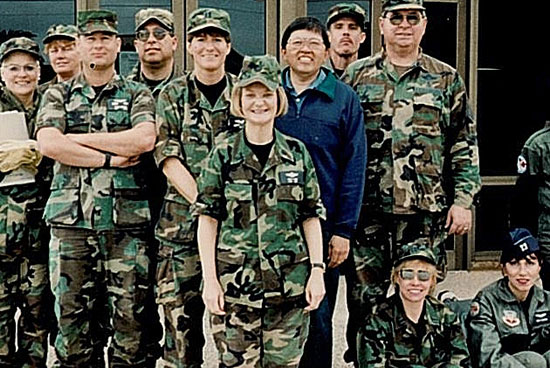
Ruth Wong, center, leading a military exercise at Camp Pendleton in 1990, a year before Operation Desert Storm.
Even as a little girl, Ruth Wong aspired to the Right Stuff.
“I knew at 8 years old that I wanted to be a nurse, and I was probably 12 when I started thinking about the military,” she remembers.
By the age of 20, she was in the U.S. Air Force, studying to become a flight nurse. By 40, she was in the Persian Gulf, commanding 50 medical personnel, sleeping in a chemical suit and packing a 9-millimeter sidearm.
By the time she retired from the service in 2001 and went to work for Los Angeles County, she was a Brigadier General.
So last week, as U.S. Defense Secretary Leon Panetta lifted the ban on women in combat, Wong—who last month became the first woman to head the Los Angeles County Department of Military and Veteran’s Affairs—cheered it as a step in the right direction for the institution that had helped her realize her heart’s desires.
“They’ll have to be physically able, emotionally strong, and be able to fight shoulder-to-shoulder with their male counterparts,” she says. “But this is going to afford an opportunity for women to advance in career fields they may have dreamed about for a very long time.”
Wong, who moved to the military and veterans affairs department in August after nearly a decade as executive director of the county’s Quality and Productivity Commission, says she sometimes thinks that her whole life has been leading her toward her current job.
“When I came here, I was told it would be a temporary assignment,” says Wong, who became acting director after the retirement of Col. Joseph N. Smith in December. “But after a couple of months, I began to think, ‘This is where I belong.’”
The department, which helps L.A. County veterans access housing, education, mental health care and other services, offers a front-line view of the military’s evolution and of veterans’ evolving needs. A 2010 study by the Economic Round Table counted 328,000 veterans in Los Angeles County, including some 36,000 who had served since 9/11. That total, Wong says, has since grown to an estimated 400,000, and is projected to grow further by 2017 as forces in Afghanistan and Iraq complete planned drawdowns.
“About a third of the young people coming back from Iraq and Afghanistan are suffering from post-traumatic stress or some other mental health issue,” Wong says. “Those who aren’t suffering from post-traumatic stress are having to adapt to a new environment.”
And, Wong says, the new veterans are twice as likely to be female; 13% of veterans returning from Iraq and Afghanistan are women, compared to 6% of veterans overall, according to the Economic Round Table. The ban on women in combat notwithstanding, she says, the female veterans now have seen more action than at any time in U.S. history, and are coming home with not only that trauma, but with a whole set of needs specific to women.
“Some are coming back as primary caretakers to families and children, or maybe to a husband they have to bond with again,” she says. “We are seeing women who, unfortunately, are getting divorced, with young children, and have no job and don’t know where to go.”
Wong understands these struggles, both as a married woman and as a veteran who has watched the military evolve since the early 1970s. When she WAS commissioned as an Air Force officer, fresh out of nursing school in Chicago, the Vietnam War and the draft were winding down and the Equal Rights Amendment was being debated. Women made up less than 2% of the armed forces and were barred from two-thirds of the military job specialties.
“I wasn’t a feminist,” she says, recalling that her main motivation had been to travel without having to postpone her career in nursing. In fact, when her World War II-veteran father feared aloud for her safety, “my response was, ‘I’m going to be a nurse in a hospital—I probably won’t even carry a gun.’”
She met her husband, a Pasadena physician, while they were both stationed at a New Mexico air base. She served at Point Hueneme while he built a Southern California practice. Then, in 1991, war struck. Wong was promoted to flight commander of Aeromedical Evacuation Operations at the Sharjah Air Base in the United Arab Emirates. Though Operations Desert Storm and Desert Shield never brought her directly into combat, she says, she was responsible for scores of subordinates and there were frequent threats of chemical attack from SCUD missiles.
The experience shaped her in ways she recognizes in the veterans she serves now.
“I was stronger when I came back,” she says. “Just being in a country that was so different, in a wartime scenario, working with people I’d never worked with before—just being able to survive all that gave me a feeling of, ‘I can do almost anything. I’m a little bit more of a superwoman than I thought I was.”
It also sensitized her to veterans’ struggles. “They’ve faced so many things that others haven’t had to experience or face,” she says. “Things in their hometowns are different. They’re different. When I came back from the Persian Gulf, I was different.”
And, she says, so were her loved ones. “My husband is a jovial person, and when I came back, people told me over and over, ‘Your husband didn’t smile the whole time you were gone.’”
The 6-month deployment moved Wong up the ladder; her final decade in the military was spent directing and administering nursing services for the Air Force at Andrews AFB and in the Surgeon General’s Office in Washington, D.C.
She retired just before 9/11 and returned fulltime to Pasadena, where she and her husband had based their temporarily bicoastal marriage. Then the military changed her life again.
This time, it was a phone call from an old Air Force buddy, wondering if she would be interested in an opening at Los Angeles County, where the friend now worked. Soon, Wong, who had spent six years consulting with nurses to make Air Force field units more efficient, was evaluating efficiency at the county Department of Mental Health.
That gig led to the job as executive director at the Quality and Productivity Commission, and, in turn, to her current job—proving, she says, that with or without combat experience, military service can be valuable in the civilian workplace.
As can Air Force buddies. “As they say, 66% percent of all jobs are gotten through networking,” she says with a laugh.
Posted 1/31/13
Putting the fab in pre-fab on Skid Row
November 29, 2012
Architect Michael Maltzan builds museums and mansions. His latest commissions include an addition to the American ambassador’s residence in Paris, a new pier in St. Petersburg, Florida, and an arts center for Rice University. Architectural Digest hails his “visionary approach” and the New York Times has dubbed him “a darling of wealthy art world patrons.”
So what’s an acclaimed architect like Maltzan doing in a place like L.A.’s Skid Row?
You’d be amazed.
Maltzan, whose firm is based in Silver Lake, is helping to rewrite the playbook on designing housing for the homeless in Los Angeles. Over the past five years, his two projects for the non-profit Skid Row Housing Trust—the Rainbow Apartments and the New Carver Apartments, next to the 10 Freeway at Hope Street—have pushed the envelope of what it means to create shelter while fostering a healing sense of community.
Now he’s at it again, venturing for the first time into a project that will graft pre-fabricated housing units onto an existing, multi-use single-story building at 6th Street and Maple Avenue. A new “structural tray” atop the original building will support the network of 100-plus studio apartments being trucked in from a factory in Idaho, while also forming a kind of outdoor mezzanine with community gardens, jogging track, basketball court, yoga platform and shared kitchen, laundry and computer room spaces. Supportive services, including a ground-floor medical clinic, will serve not just the residents of the new Star Apartments, but also people who live in the surrounding community.
The first units won’t be installed until December and the building isn’t set to open until next spring or early summer, but already Maltzan’s design is being lauded for its “elegant composition of prefabricated blocks.”
The Star project represents “a big innovation,” says Mike Alvidrez, the Housing Trust’s executive director. He praises Maltzan for bringing “a very fresh, innovative way of thinking about buildings…in particular when it comes to how design can be influential in terms of helping people recover from homelessness.”
Creating social, communal interactions is a big part of the Star’s design. The homeless, Maltzan says, “live on the street all the time. We think that they must be very well adjusted to living in public, but the reality is, the only way a human being is able to survive in that kind of situation without any private life at all is to create that private life within themselves, and start to create a real shell around themselves and disconnect from culture and community around them.”
So unlike the old transient hotel experience, where “you felt like you were under surveillance” when you entered the lobby and then “disappeared into your room and were never seen until you came back out,” the Star is designed so residents will step onto a walkway or balcony when they leave their units.
“You are moving through a more social situation,” Maltzan says.
He’s also excited about his first foray into pre-fabrication. Using pre-fab methods to build multi-family housing is more economical, efficient and environmentally-friendly than traditional construction methods—and, contrary to old stereotypes, offers sturdier, easier-to-maintain living spaces, he says.
“It allows us to reach a higher level of quality for the same cost,” he says. “When I say higher level of quality, it’s not making it fancier. It’s making it better, more durable, and nicer to use when you’re in the unit.”
And looks matter—whether you’re building a 28,000-square-foot residence for a mogul like Michael Ovitz or a 340-square-foot refuge for someone used to sleeping on the street.
“A big part of our goal,” Maltzan says, “is to say that architecture and design and beauty are something that should be accessible to the full range of the population of Los Angeles County.”
Not everybody saw it that way, at least initially. After the opening of his first Skid Row Housing Trust project, the Rainbow, some people asked him:
“Why are you making these buildings look so good? Why are you making them so identifiable? That must be more expensive. Why aren’t you just housing these people?”
Maltzan disagrees—not just on the expense question but on the notion that good design is just for the privileged. And he’s heard the same thing from people who live in his buildings, including the Rainbow.
“I’ve been to that building many, many, many times. I’ve been there when people knew I was the architect and I’ve been there when people didn’t know I was the architect. And the thing I get again and again and again from that community is, ‘We live in a place that looks like something, as opposed to a place that looks like nothing.’ ”
The new approach to building for the homeless is part of an overall shift that emphasizes the value of creating “permanent supportive housing,” which provides not just a roof overhead but surrounds residents with vitally-needed medical, mental health and other services. Project 50, which targeted some of the most entrenched residents on Skid Row for such housing, is a widely-cited success story, praised for transforming lives and saving money.
The Star Apartments, the first pre-fab homeless housing complex in L.A., is expected to embody those principles—and perhaps provide a template for the future.
“I think we could use many, many more projects like this,” says Alvidrez, of the Skid Row Housing Trust.
For his part, Maltzan thinks important elements in the Star Apartments could work all over Los Angeles—and not just for a homeless clientele.
“I can’t wait to do another project like that,” he says.
Maltzan, 53, who grew up in Levittown, N.Y. and was educated at the Rhode Island School of Design and at Harvard, moved to Los Angeles in 1988. He and his wife, Amy Murphy, an architecture professor at USC now pursuing a PhD in the university’s School of Cinematic Arts, now live with their two children in Pasadena.
He considers L.A. “the most compelling laboratory for thinking about the future of cities and the future of architecture in relationship to those cities.”
And he thinks he sees a glimpse of the future in the homeless housing efforts now afoot.
“As a citizen in the community, it makes me feel optimistic that you can effect change in a positive way in what most people have said is an intractable dynamic, that homelessness just can’t be changed, that that community is lost,” he says. “That is not the case. You can effect real change.”
There’s also a sense of vindication for his profession as a whole.
“One of architecture’s responsibilities is to use its capacity to continue to move cities and communities forward. And that includes making very pragmatic and functional buildings, cost-effective buildings, but also buildings that look like something, that stand for something, that aren’t shy in creating iconic structures that are for the culture as a whole,” he says.
“It’s extremely important for us to make the very best for the wealthiest segments of our community as well as for the less privileged in our communities. And it’s only when we work in all of those segments that you have any hope of creating a viable, sustainable, progressive metropolis.”
Posted 11/29/12
Helping kids be a force “4GOOD”
November 20, 2012
Maybe, as the ‘80s bestseller says, everything we need to know we learned in kindergarten—but for the Athanas and Goldman families, it turned out that wasn’t nearly early enough.
The San Fernando Valley couples, close friends since their children were in preschool together, wanted to find a way for even the youngest members of their families to taste the joy of generosity.
“We’re both civic-minded families, and we wanted to involve our kids in giving back,” says Erika Athanas. But there was a problem: most of the volunteer opportunities they encountered were geared to high school students and adults. Even the best-intentioned little kids weren’t a good fit for dishing out dinner at a homeless shelter, for instance.
So an idea was born and, this being 2009, that idea came with a Facebook page. The goal, initially, was just to reach out and see if there were other people searching for child-friendly volunteering events and causes that make it possible for families to unplug and spend time together while making the world—or at least a small corner of it—a better place.
The answer was a resounding yes. And today, the nonprofit organization the families created, 4GOOD, has grown into a social networking success story and home-crafted online resource center. Athanas, who co-founded the group with her husband, Peter, and their friends Katie and Jeff Goldman, estimates there are now 2,500 “4Gooders” involved with the organization.
“I cannot tell you how many people have reached out to us to say, ‘Why don’t organizations include children? Why is it so hard to find them?’ ” Athanas says.
Responding to the demand, 4GOOD’s first annual “Family Day” earlier this year attracted hundreds of participants (look for the next one on April 7, 2013.) Kids got a hands-on taste of volunteering by making placemats and flower pots for seniors who receive Meals on Wheels and by crafting cards for military service members as part of Operation Gratitude.
The calendar on the 4GOOD website links to dozens of activities, ranging from helping out at the Baby2Baby Warehouse distributing “gently used” gear to needy families to cleaning cages and handing out hay to rescued bunnies at a shelter. This month, 4GOOD is asking its members to take part in a pre-Thanksgiving food drive sponsored by Jewish Family Service’s SOVA program. And on December 2, they’re joining forces with the group Friends & Helpers on an Adopt-a-Family/gift wrapping event in Tarzana.
Last year, Scholastic’s Parent & Child magazine recognized the group’s work by selecting the Athanases as its Family of the Year.
That brought a cover photo shoot, an appearance with Hollywood stars William H. Macy and Felicity Huffman, and even an online storybook populated with illustrated versions of Erika, who works part-time in product development, Peter, a business consultant, and their sons: Izak, now 12, and Eli, who’s about to turn 8.
Along the way, 4GOOD hasn’t just made a difference in the lives of others. It’s also been a transformative force for the founders’ own families.
“I really feel my kids will be better human beings and better adults because I’m showing them the way,” says Athanas, who “never volunteered in my life until I was in my 30s” but wanted things to be different for her children.
“A lot of these things that we suggest to do are fun. We want them to have fun and to enjoy it,” she says. “My own kids drag their feet sometimes, of course. That’s the nature of being a kid. But at the end of every single thing, they end up saying ‘You were right, Mom. That was really incredible.’ ”
Posted 11/20/12
She’s No. 1 at First 5 L.A.
October 12, 2012
Los Angeles’ youngest children have a new friend in high places.
Kim Belshé, the former head of the state Health and Human Services Agency, has been named executive director of First 5 L.A.
“I really think that First 5 L.A. can be the leading voice in the state for improving outcomes for young children and their families,” Belshé said in an interview. She said she is looking forward to helping her organization “change the life trajectory of young children in Los Angeles County.”
Supervisor Zev Yaroslavsky, chairman of the First 5 board, praised Belshé as a prominent and accomplished leader who has what it takes to lead the children’s organization forward.
“She is one of the most respected leaders in health and human services in the state of California,” he said in a statement. “Kim is committed to First 5’s mission of improving the quality of life of all children 0-5, and she has the talent, intellect and skill to do this job.”
First 5 L.A. was created to oversee the county’s allocation of funds from Proposition 10, the Rob Reiner-supported initiative that imposed a 50-cents-a-pack tax on cigarettes to raise revenue to improve the lives of California’s youngest children.
In July, First 5 announced an ambitious plan to accelerate spending of the funds it has received. Nearly $400 million is now in the pipeline to fund anti-obesity efforts, along with health, dental and vision care services as well as an unprecedented project to house homeless children and their families.
In 2011, a scathing audit criticized the agency for moving far too slowly in spending its available funds. No malfeasance was found, however. The agency’s previous executive director, Evelyn V. Martinez, resigned in November, 2011.
Belshé, 52, a San Francisco native, currently is senior policy advisor with the Public Policy Institute of California. She has a bachelor’s degree in government from Harvard and a master’s in public policy from Princeton.
She begins work with First 5 early next month.
Posted 10/12/12




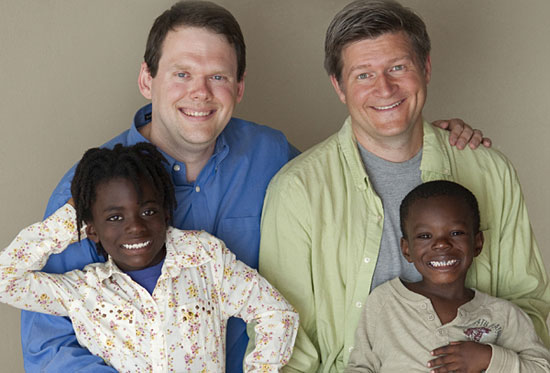
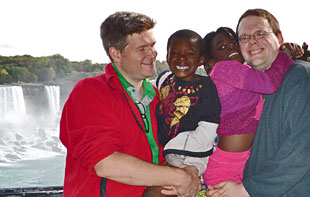
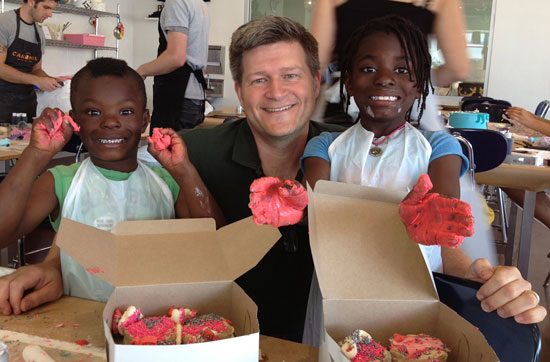

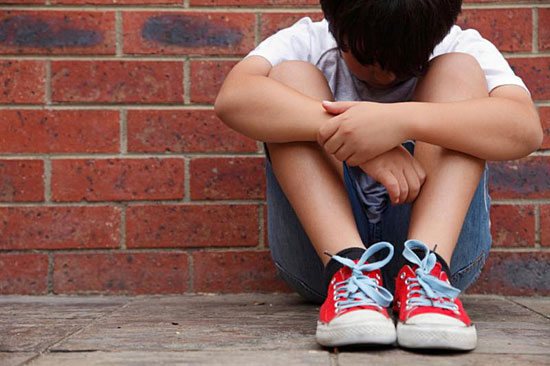
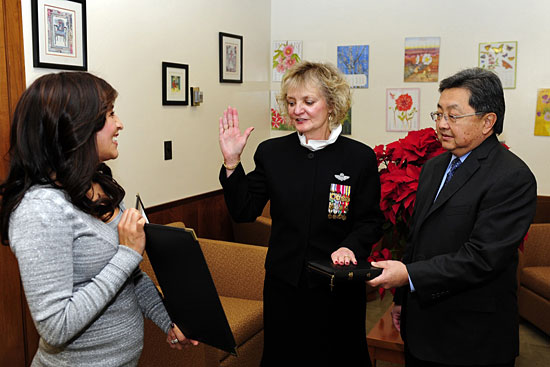
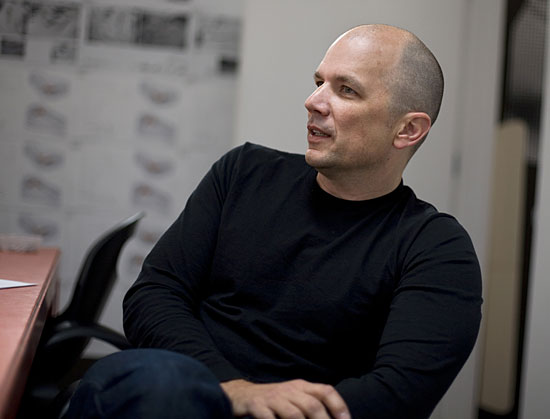

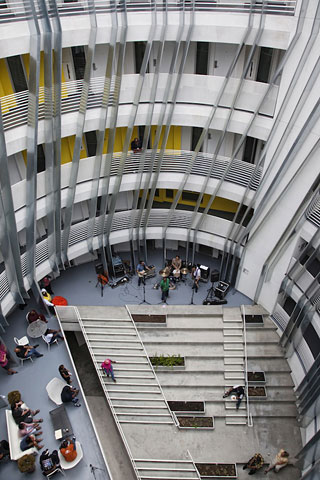

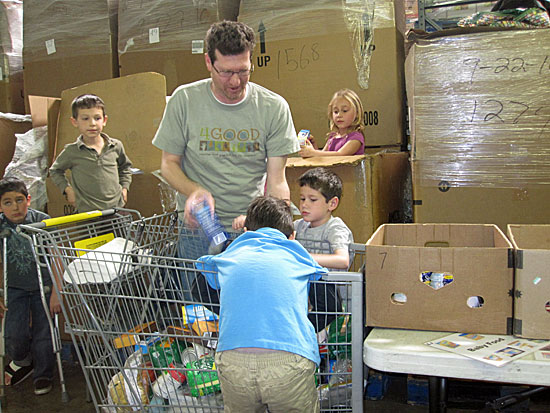
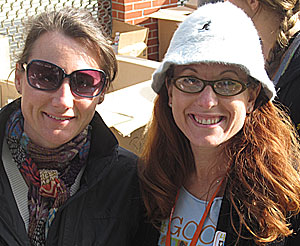

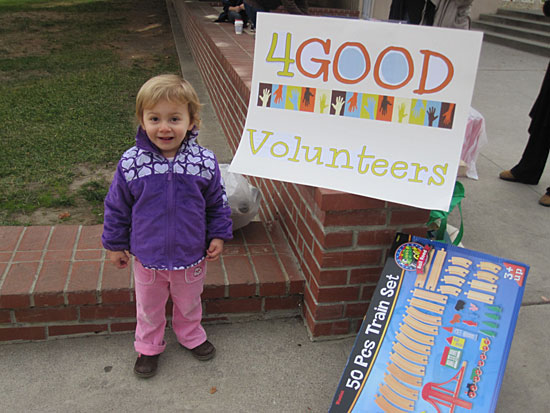
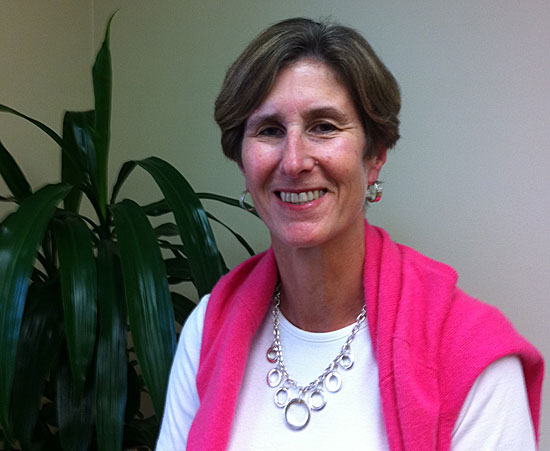







 405 bridge work causes a stink
405 bridge work causes a stink

